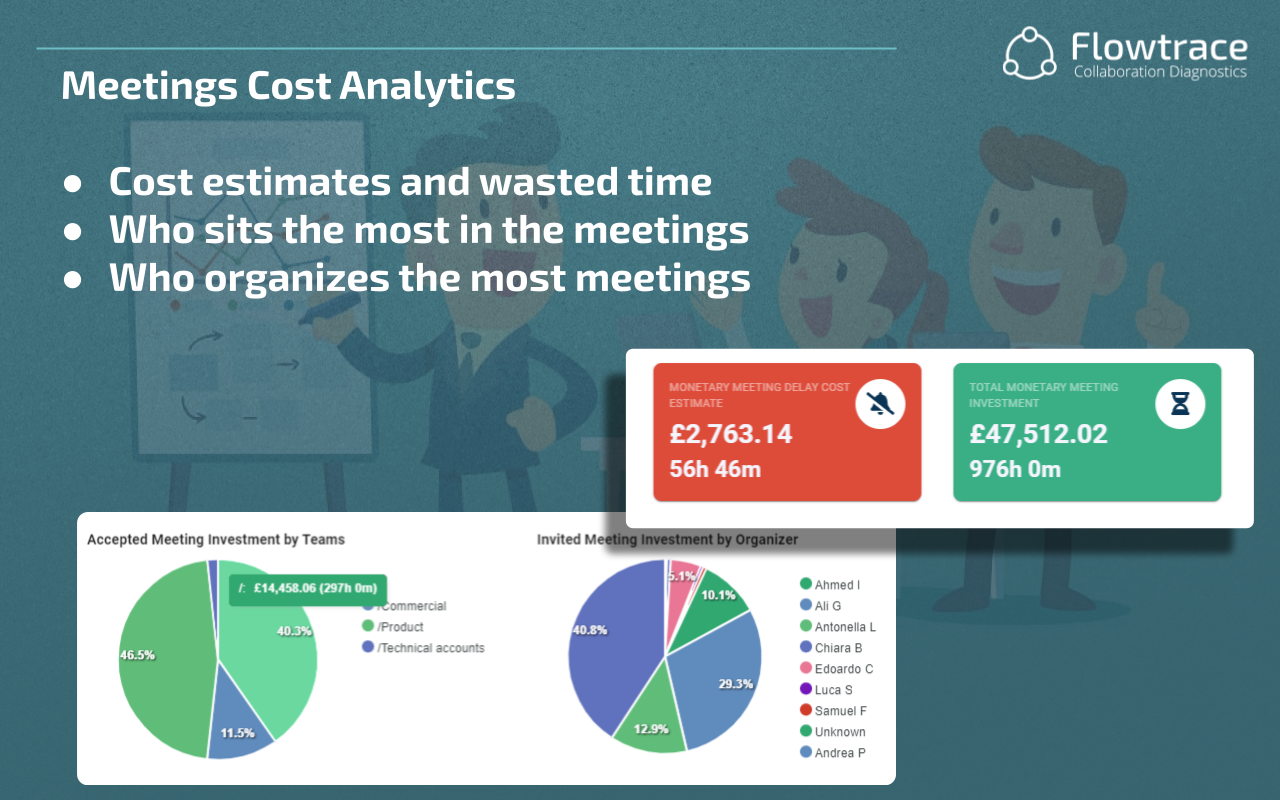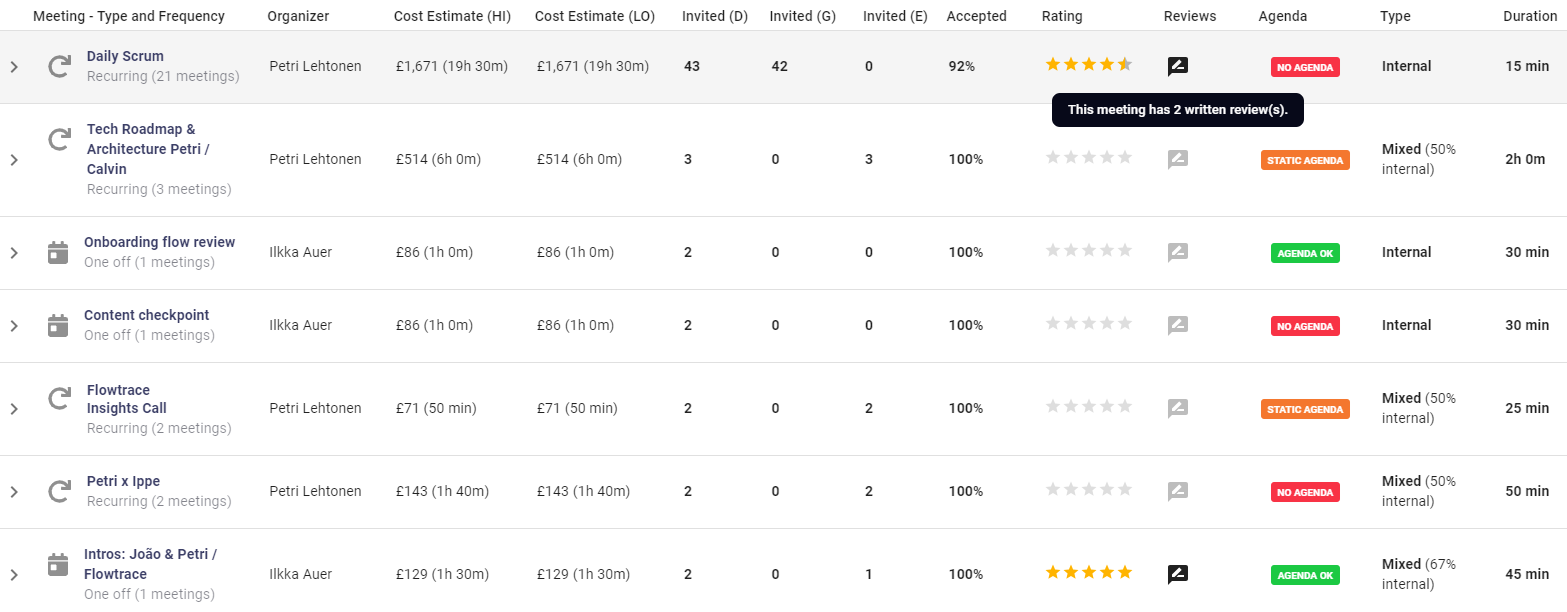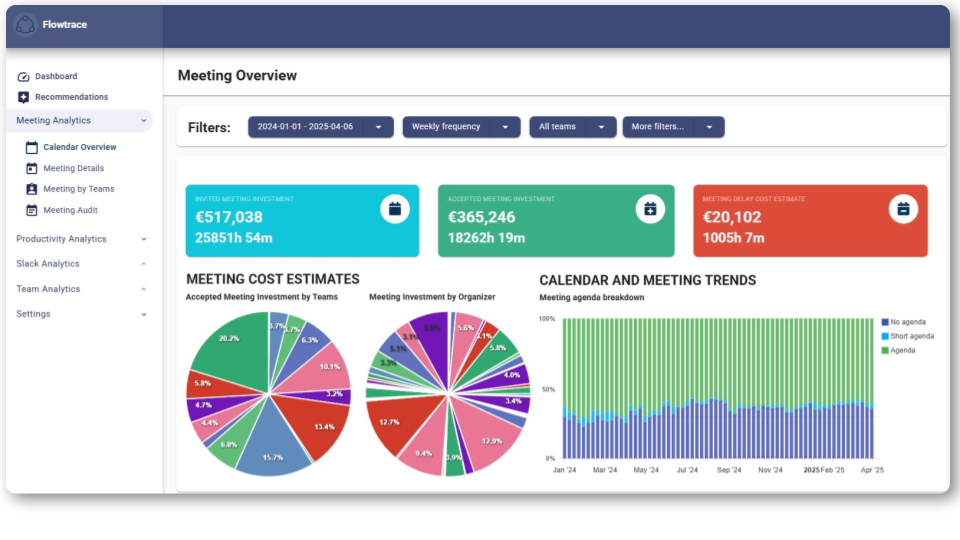If you’ve ever opened your calendar on a Monday morning and felt overwhelmed by the wall of meetings, you’re not alone. Meeting overload is one of the most common complaints in modern organizations. Despite endless productivity tools, better workflows, and guidance on collaboration, calendars only seem to get more crowded.
The truth is, meetings aren’t inherently bad. At their best, they are essential moments of alignment and decision-making. But when meetings multiply without intention, they consume time, money, and focus that could be better spent elsewhere.
So why do we have so many meetings? The answer lies in a mix of cultural habits, lack of visibility, and structural gaps that encourage meetings by default rather than design. By understanding the root causes, leaders can take meaningful steps to reduce overload and create a healthier meeting culture.

Reasons for of Too Many Meetings
Blindness to Meeting Costs
Most organizations don’t think about meetings as financial drains. Yet every meeting has a cost. A one-hour meeting with 10 people isn’t just 'one hour', it’s 10 hours of collective time, multiplied by salary costs.

Because these costs are hidden, meetings are treated as free. This perception creates an environment where scheduling 'just one more call' feels harmless, even though the real expense adds up quickly. Without cost awareness, there’s little incentive to reduce or redesign meetings.
Lack of Calendar Visibility
Few organizations regularly audit their calendars. Teams rarely ask questions like: 'How much of our week is spent in recurring meetings?' or 'Do we need this weekly check-in?'
Without meeting analytics, meeting sprawl feels normal. The sheer load of recurring series, standing check-ins, and ad hoc sessions accumulates silently until calendars hit a breaking point. Leaders who have visibility into meeting analytics are often shocked at how much time is consumed by low-value sessions.
No Clear Decision-Making Frameworks
When responsibilities and decision rights are unclear, meetings become the default solution. Instead of clear ownership, teams bring issues into a group setting to gain alignment or avoid risk.
This slows decision velocity and clogs calendars with sessions that could have been avoided if clarity existed upfront. Organizations with well-defined decision frameworks tend to have fewer, more purposeful meetings.
Poor Balance Between Async and Sync
Too often, meetings are used to share information rather than make decisions. Status updates, reporting, or background discussions all get squeezed into live meetings, even though they could be handled asynchronously.
This imbalance creates unnecessary load. Live meetings should be reserved for tasks that benefit from discussion, debate, or creativity. Everything else can and should move to async tools such as shared documents, project management platforms, or recorded updates.
Fear of Missing Out (FOMO)
Another reason calendars are full? People attend meetings simply to 'stay in the loop.' Leaders don’t want to miss decisions, employees don’t want to be excluded, and so the attendee list grows.
This creates bloated meetings where only a few participants actively contribute. FOMO-driven invites expand the problem and reinforce the idea that presence equals productivity.
Recurring Meetings Left Unchecked
Recurring meetings are particularly dangerous because they run indefinitely. Weekly check-ins, monthly reviews, or quarterly updates often continue long after their purpose has faded.
Without regular review, these meetings become calendar fixtures, consuming time without delivering proportional value. When multiplied across functions, unchecked recurring meetings are one of the biggest drivers of overload.
Lack of Meeting Policies

Organizations without clear meeting policies quickly fall into chaos. Without rules such as 'agenda-or-cancel,' 'action items required,' or 'limit attendees,' every team develops its own standards.
The result is inconsistency. Some meetings are structured, others are vague. Some end with decisions, others with confusion. Without policies, meeting quality varies wildly and bad habits spread.
Hybrid and Remote Work Defaults
In remote and hybrid setups, meetings often replace the informal conversations that once happened in hallways or offices. While this keeps teams connected, it can quickly overload calendars.
Without intentional design, distributed teams rely too heavily on synchronous time. This leads to fragmented workdays, shallow focus, and fatigue. Healthy hybrid cultures use async communication to reduce meeting dependence.
Culture of Busyness and Visibility
For some organizations, a packed calendar is a badge of honor. Being busy is seen as a sign of importance or productivity. This cultural dynamic pushes employees to accept and schedule more meetings than necessary, equating attendance with value.
The result is calendars full of activity but not necessarily impact. A culture of busyness confuses visibility with contribution.
Scheduling Ease in Digital Tools
Finally, digital calendars themselves play a role. Tools like Outlook, Google Calendar, or Slack make it easy to schedule with a couple of clicks. Adding a meeting takes seconds, but the cumulative effort required of attendees is enormous.
The ease of scheduling hides the true effort required. With no friction, meetings multiply faster than anyone realizes.
The Hidden Costs of Too Many Meetings
Meeting overload doesn’t just fill calendars. It has tangible business costs.
- Time drain: A single 30-minute meeting with 8 attendees consumes 4 collective hours. Multiply that across an organization and the total is staggering.
- Productivity loss: Time spent in unnecessary meetings reduces deep work and focus capacity.
- Decision delays: When decisions are stretched across multiple meetings, execution slows.
- Employee burnout: Frustration at wasted time reduces engagement and increases turnover risk.
- Financial cost: Salaries tied up in meetings represent real organizational expense.
In reality, meetings cost more than just time, ineffective gatherings in the U.S. alone are estimated to waste over $25,000 per employee annually, and collectively amount to more than $375 billion in organizational losses each year
How to Break the Cycle of Meeting Overload
1. Conduct Calendar Audits

Regularly review meeting load across teams. Look for recurring meetings that can be shortened, canceled, or moved to async. Analytics can highlight hotspots where time is being consumed without value.
2. Make Meeting Costs Visible

Translate meeting hours into financial terms. When leaders see the cost of a one-hour meeting with 10 executives, they begin to treat meetings more strategically. Cost visibility creates accountability.
3. Introduce Meeting Policies
Set clear standards such as:
- Agenda-or-cancel (no agenda, no meeting).
- Limit attendees to those directly contributing.
- Require action items and ownership by the end of each session.
4. Redesign Recurring Meetings
Don’t let recurring sessions run indefinitely. Review their purpose quarterly. If they no longer serve a need, cancel or reduce them.
5. Balance Sync and Async
Move status updates, routine check-ins, and document reviews to asynchronous channels. Reserve synchronous time for problem-solving, creative collaboration, and decision-making.
6. Optimize for Time and Focus
Shorten default durations (25 instead of 30 minutes, 45 instead of 60). Build calendar buffers to protect deep work. Timebox discussions to keep focus sharp.
7. Measure and Improve Continuously
 Track meeting load, feedback, and effectiveness. Use analytics to identify inefficiencies and improve practices over time. Treat meetings as a measurable business process, not just a habit.
Track meeting load, feedback, and effectiveness. Use analytics to identify inefficiencies and improve practices over time. Treat meetings as a measurable business process, not just a habit.
Reduce Your Meetings
So why do we have so many meetings? The answer lies in a mix of cost blindness, poor visibility, unclear frameworks, and cultural defaults. Without awareness, meetings multiply unchecked, consuming time, money, and energy.
But meeting overload isn’t inevitable. By auditing calendars, making costs visible, introducing policies, and balancing async with sync, organizations can reclaim control. The payoff is fewer wasted hours, faster decisions, more engaged employees, and stronger collaboration.
In today’s world, where time is one of the most valuable resources, fixing meeting overload isn’t just about efficiency. It’s about creating a healthier, more resilient organization.

Frequently Asked Questions - Number of Meetings